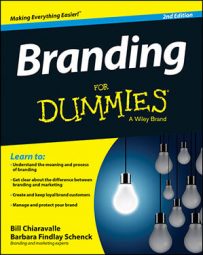To brand or not to brand, that is the question. Or at least that’s the question that hangs in the air until people who aren’t quite sure about whether they really need a brand hear this truth: More than any other quality — even more than strong financial statements, great management, or terrific product or service ideas — brands are the key to winning long-term growth and success.
By building a brand, you cast a strong, clear vision of what you stand for. Without a brand, you blur into a dime-a-dozen, one-seems-just-like-another category called commodities. In a sea of similar choices, branding differentiates and elevates your offering, paving the way for awareness, preference, selection, and profitability.
If you can think of even one way your offering is meaningfully different and better (not just different, but meaningfully different and better!), then you have at least one reason to build a brand that moves it into the prestigious realm of people, products, businesses, and organizations that stand out as distinctly different, preferable, and more valuable than all the others.
Branding to avoid the budget-busting commodity trap
Warren Buffett, widely regarded as the 20th century’s most successful business investor, sums up the formula for business success in four frequently quoted words: Buy commodities, sell brands.
Commodities are offerings that customers can’t differentiate from one another because they all seem to serve the same need, solve the same problem, and deliver the same value. If people can’t see a clear reason to buy one product over another — if they think that they all deliver the same value and quality — they buy whatever’s available at the lowest price, which is hardly a formula for business success.
Brands are the opposite of commodities. A commodity becomes a brand when those in the marketplace understand and value compelling characteristics that make it different and better than others in its category. Branding is a powerful tool that differentiates an offering in ways that develop consumer preference and deliver pricing power — the power to raise prices without losing business.
Airline tickets, laptop computers, and strawberry jam start out as commodities. All competitors address basically the same need in basically the same way, and if customers see no reason to choose one over the others, they simply opt for the one with the lowest price.
Yet every day, customers make conscious decisions to buy the offering of one airline or computer manufacturer or jam maker over the others because of the unique attributes they trust to be true about their choice. Maybe they’re won over by the frequent flyer club options, service or warranty program, organic ingredients, or any of a zillion other distinguishing characteristics — the brand promises — that they understand and believe are worth premium pricing.
As proof that brands lift offerings out of crowded commodity categories, look at the following examples:
| Commodity | Brand |
|---|---|
| Soft drinks | Coca-Cola |
| Water | Evian |
| Sneakers | Nike |
| Technology | Apple |
| Razor blades | Gillette |
| Internet search | |
| Online retail | Amazon |
| Logistics | UPS |
| Coffee | Starbucks |
| Lingerie | Victoria’s Secret |
When you build a brand, you develop value, trust, preference, and the potential for higher prices and profit margins.
Branding to cast your vision
Your brand reflects the vision of the good that you aim to achieve. Just as the images on a country’s flag symbolize the core of what’s important to that culture and nation, your brand reflects the core of what’s important to you and your organization. It’s the banner that signifies what you’re passionate about, your fundamental values, what you aspire to achieve, and the promise on which you stake your reputation.
A well-defined vision is important whether you’re building a personal brand or an organizational brand:
If you’re developing a personal brand, your vision clarifies the qualities and characteristics for which you want to be known. It keeps you on track and steers the presentation of an authentic, well-aligned voice and presentation in all personal communications, whether online and offline.
If you’re developing a product, business, or nonprofit brand, your vision defines why you’re doing what you’re doing and the ultimate good you want to achieve through your success. Establishing a clear vision keeps your entire team on track and makes branding an almost-transparent process. By understanding the long-term vision you’re working to achieve, the brand promise becomes a commitment that’s caught, not taught, throughout the organization.
Great brands stem from the beliefs, personalities, and values of those leading the brand. They result in a brand culture that’s authentic and heartfelt.
Branding to win trust and increased value
Amid a deluge of unfamiliar options, brands stand out as friends you can count on. That trust leads to selection, purchase, and, for the brand-builder, profitability.
Instinctively, you’ve proven the influence of brand trust thousands of times over. Think of the last time you reviewed job applicants, or scrolled through screen-after-screen of shoe choices, or scanned reviews for movies playing in town. You had to make a choice, and chances are good that you opted for the offering you thought you could trust. Branding, or lack thereof, led to your selection.
If you viewed all the choices as similar and fairly risk-free, you probably let convenience or low price tip your decision. That’s because no single offering inspired your trust or presented distinguishing benefits, so you went with the quickest, least-expensive option.
But if, after scanning all your options, you settled on an offering that took you out of your way or caused you to pay a little or a lot more, your decision was likely based on a sense that the one you selected was worth the price or the trouble because you believed it wouldn’t let you down. That trust, almost certainly, was the result of good branding.

